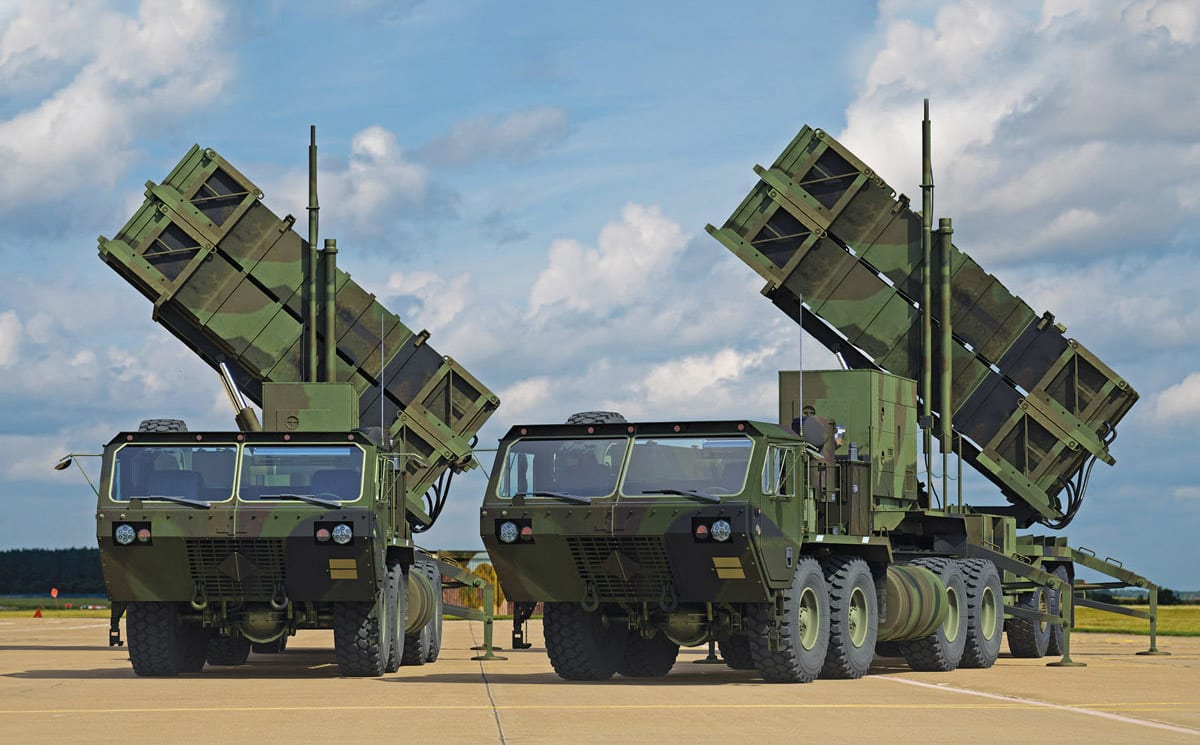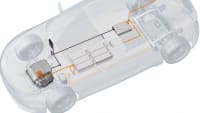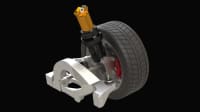The Power Behind the Growth in Intelligent Munitions

Since the introduction of intelligence munitions in the late 1960s, weapons technology has undergone a dramatic transformation. Intelligent munitions can locate, identify and attack targets over long distances with speed and accuracy. Leveraging advancements in high-reliability computing, advanced sensors and positioning and guidance systems, intelligent munitions demonstrate higher accuracies, achieving improved success rates with less collateral damage. OEMs are increasingly leveraging artificial intelligence (AI) as they develop the latest intelligent munitions platforms, for example in the rapidly growing market for loitering munitions. Loitering munitions are drones which hang over a target area while leveraging next-generation intelligent video surveillance and analytics to identify threats and targets.
These drones are extremely agile and adaptable, with the ability to initiate high-precision strikes, and are proving their value in the ongoing Ukraine-Russia conflict. The key trends driving the high-growth market in loitering munitions include, swarm technology, artificial intelligence (AI), vertical attack, military off-the-shelf (MOTS), commercial off-the-shelf (COTS), 3D printing, miniaturization and scalability, composites, mission modules, and battery technology. The United States is currently an innovator in this space, with the Pentagon’s Replicator Initiative, for example, which aims to develop swarms of unmanned combat drones that will use AI to seek out threats.
The performance of these modern, sophisticated weapons systems is fundamentally dependent upon the power-delivery subsystems which ensure that supply rails remain stable even while the weapon is subjected to extreme environmental conditions such as shock, vibration and high transient temperatures. This article describes the technologies enabling the evolution of intelligent munitions and focuses on the importance of stable power supplies.
Intelligent Munitions Leverage Advancements in Electronic Technologies

Although the final decision to initiate a bomb or missile strike remains in the hands of the human operator, intelligent munitions have significant levels of autonomy, enabled by a group of core technologies. Positioning and guidance systems equip modern weapon systems with the capability to find and steer themselves to the intended target, determining the shell’s orientation and velocity at every point, from launch to impact. Infrared or radar guidance, for example enables the weapon to follow the heat signature or the trajectory of a designated target. With artillery shells, inertial guidance is common, where data from internal gyroscopes and accelerometers allows the shell to follow a pre-programmed trajectory. Global Positioning System (GPS) signals are used in longer range situations to guide the weapon or to augment accelerometer and gyroscope data.

Sensor components are also vital to the performance and accuracy of intelligent munitions. Along with accelerometers and gyroscopes, data from radiofrequency (RF) and position-assessment, temperature, humidity and pressure sensors, is used to help compensate for environmental changes during transport and after firing, feeding data to a central computing unit.
High reliability computing units are the brains of intelligent munitions systems, equipping the weapon with decision making capability. Although both dumb and smart shells contain a fuse, the processor in intelligent munitions, enables a more sophisticated fuse system, where the decision to detonate the payload is based on sensor readings and external data. Additionally, the processor executes guidance algorithms, sending commands to actuators which control trajectory. Stepper motors, for example, can change the attitude of external fins to alter the shell ‘s trajectory and air speed.
Wireless Communications technologies including RF transceivers allow the weapon to be controlled remotely control from a command unit or enable it to relay mission critical data to other battlefield assets. Electrical Power Delivery subsystems are key to the reliability of intelligent munitions. The electronic components within the processors, sensors, actuators and communication systems all require stable supply rails with tight tolerance levels which are consistent throughout the various stages of the weapons life, from storage through transport, launch, flight and, eventually, detonation.
Reliable and Stable Power Delivery is Essential Throughout the Lifecycle of the Weapon System
The performance and reliability of all the above systems are dependent upon stable supply rails, delivering consistent electrical power within tight tolerance levels. An onboard energy source will supply this power through one or more DC/DC converters, with the nature of the energy source varying according to the type of weapon.
Smaller guided munitions tend to use lithium batteries because of their high energy density while onboard generators powered by small internal combustion engines or microturbines deliver sustained power for longer range applications. Generators usually require some form of secondary power source to handle startup times and other transient states. Functions such as steering and detonation require quick bursts of power, which can be delivered by supercapacitors. In the growing field of loitering munitions, energy can be harvested from ambient sources such as light, vibration or air movement to deliver long-term but low levels of energy.

Given the complementary nature of these energy sources, many smart munitions designs contain more than one energy-generation subsystem, with the supplied power switching between sources during operation of the weapon. The voltage output from battery cells, for example, may decline rapidly near the end of their discharge cycle, which will tend to occur close to the point of final detonation. Backup energy systems may take time to reach full power output when switched in to replace a depleted primary source, leading to rapidly changing input voltages.
Whatever the energy source, DC/DC converters play a critical role in optimising energy efficiency and avoiding damage to components that can result from voltage variations if unregulated supplies are used.
The Essential Role of the DC/DC Converter

The electronic components within intelligent munitions systems must be powered correctly at all times. Switching between power sources under periods of high stress can lead to large variations in the voltage generated by the energy source, but DC/DC converters designed for intelligent munitions, such as the MGDD range from GAIA Converter, guarantee consistent and stable power delivery to the electronic subsystems of the weapon. Converters such as the MGDD range ensure that the rail voltages remain consistent over a range of input voltages as wide as 12V to 160V.
Space is severely limited in intelligent munitions systems and DC/DC converters must compete for scarce real estate with explosives, energy sources, actuators and electronics, and so form factor and weight are critical parameters. The height of passive components, such as capacitors and inductors can be a particular issue for power supply designs, making it difficult to fit the power supply into the shell casing. Converters must therefore be lightweight and small to meet this requirement.
Intelligent munitions operate in hostile environments and electronic components, including DC/DC converters, must withstand large temperature swings, both in storage and deployment. Thanks to its two-component potting compound, GAIA Converter’s MGDD series easily meets this requirement, with a storage temperature range of –40 to +125°. The high thermal conductivity of this potting compound optimizes heat dissipation under harsh environmental conditions, and the compound also provides protection against damage from shock and vibration.
Electronic components for military applications are subject to stringent standards on product quality and behaviour, and various standards apply, depending upon the type of component, with standards such as MIL-STD-810 and MIL-STD-331 defining system and reliability tests, and MIL-STD-461 specifying electromagnetic compatibility (EMC) requirements.
As the deployment of smart munitions increases and more functionality is packed into smaller casings integration and development speed are becoming critical to product success. In this rapidly evolving market, integrated power modules offer significant benefits to the developer. The PSDG-48 module delivers 48W across three output power rails from a single 16-60V DC input and the module requires minimal external components, with an integrated filter delivering high EMC immunity, and a single external capacitor protecting against interruptions from the onboard energy source.
Intelligent munitions rely on sensitive electronic subsystems to achieve high levels of accuracy and reliability. As the diversity of onboard power sources increase, flexible and reliable DC/DC converters ensure stability of power rails throughout adverse operating conditions.
This article was written by Christian Jonglas, Customer Support Manager, GAIA Converter (Le Haillan, France). For more information, visit here .
Top Stories
INSIDERDefense
![]() F-35 Proves Nuke Drop Performance in Stockpile Flight Testing
F-35 Proves Nuke Drop Performance in Stockpile Flight Testing
INSIDERMaterials
![]() Using Ultrabright X-Rays to Test Materials for Ultrafast Aircraft
Using Ultrabright X-Rays to Test Materials for Ultrafast Aircraft
INSIDERManufacturing & Prototyping
![]() Stevens Researchers Test Morkovin's Hypothesis for Major Hypersonic Flight...
Stevens Researchers Test Morkovin's Hypothesis for Major Hypersonic Flight...
INSIDERManufacturing & Prototyping
![]() New 3D-Printable Nanocomposite Prevents Overheating in Military Electronics
New 3D-Printable Nanocomposite Prevents Overheating in Military Electronics
INSIDERRF & Microwave Electronics
![]() L3Harris Starts Low Rate Production Of New F-16 Viper Shield
L3Harris Starts Low Rate Production Of New F-16 Viper Shield
INSIDERRF & Microwave Electronics
Webcasts
Energy
![]() SAE Automotive Engineering Podcast: Additive Manufacturing
SAE Automotive Engineering Podcast: Additive Manufacturing
Manufacturing & Prototyping
![]() A New Approach to Manufacturing Machine Connectivity for the Air Force
A New Approach to Manufacturing Machine Connectivity for the Air Force
Automotive
![]() Optimizing Production Processes with the Virtual Twin
Optimizing Production Processes with the Virtual Twin
Power
![]() EV and Battery Thermal Management Strategies
EV and Battery Thermal Management Strategies
Energy
![]() How Packet Digital Is Scaling Domestic Drone Battery Manufacturing
How Packet Digital Is Scaling Domestic Drone Battery Manufacturing
Materials
![]() Advancements in Zinc Die Casting Technology & Alloys for Next-Generation...
Advancements in Zinc Die Casting Technology & Alloys for Next-Generation...
































